Seafood lovers abound in every corner of the world. As populations continue to grow, seafood farmers and purveyors in British Columbia, Canada, continually increase efforts to keep up with growing demands. Some of the finest quality sustainable seafood in the world comes from Baynes Sound and the waters surrounding Vancouver Island. Fanny Bay Oysters, Manatee Holdings, and BC Salmon Farmers Association in British Columbia continue to use safe and healthy farming practices to assist nature in staying ahead of the snowballing requests for seafood today.
Fanny Bay Oysters
Taylor Shellfish Farms owns Fanny Bay Oysters in addition to other business lines in Washington, California, and Hawaii. Using innovative growing techniques, quality processing, and safety testing while harvesting, Fanny Bay Oysters exports Pacific oysters and Manila clams worldwide.

Fanny Bay Oyster Shells. Photo by Tracy Ellen Beard.
Touring Fanny Bay Oysters
In June 2017, I attended the BC Shellfish Festival in Comox Valley where I tasted some of the freshest most astounding seafood ever. Chefs from all over Canada, the US, and even India came to compete and cook locally sourced seafood. While visiting Vancouver Island, I was fortunate to tour Fanny Bay Oysters where General Manager Brian Yip educated our group about where Fanny Bay oysters originate, their growth process, and how they eventually land on someone’s plate.

Fanny Bay Oysters. Photo by Tracy Ellen Beard.
Brian explained that egg fertilization begins in the warm waters near Kona, Hawaii. The developing larvae float around until attaching to clean older shells, and then plant personnel ship these young oysters, known as spats, to the nutrient-rich protected waters at Fanny Bay in British Columbia. Oysters continue to grow for another 12 to 18 months, on the land and in the sea, before employees harvest and sell the oysters either shucked or in the shell. Brian said, “About one-third of Fanny Bay oysters go to the US, one-third stay in Canada, and one-third get shipped to Asia.”
In 2017, Fanny Bay opened a new business in Vancouver, B.C., with a full-service restaurant, shellfish market, and future plans to be the primary seafood seller to Vancouver restaurants.
Oyster shucking is an art, and individuals from all over the world compete to see who shucks the fastest and cleanest. In May 2017 staff from Fanny Bay brought oysters to China and met up with professional shuckers from around the world. The two groups gathered for a shucking contest on top of the Great Wall of China. In May 2018, Fanny Bay Oysters along with Taylor Shellfish Farms will host the Oyster Opening World Cup in China.
Savoring the Oysters
Oyster connoisseurs consider these little gems a delicacy and an aphrodisiac. Whether prepared as Oysters Rockefeller with a rich butter and herb sauce topped with toasted bread crumbs, barbequed with bacon, or served raw on the half shell with lemon and cocktail sauce, oyster lovers relish the fresh taste of the sea.

Oyster Rockefeller. Photo by Tracy Ellen Beard.
Manatee Holdings
Eric Gant owns and operates Manatee Holdings on Vancouver Island in British Columbia. Gant, the world-renowned authority on geoduck clam aquaculture, opened his own shellfish hatchery in 2000. The growing demand for healthy protein-rich food drives the sustainable aquaculture community to responsibly produce farm-raised seafood while simultaneously rebuilding native species populations.

Geoducks at Manatee Holdings. Photo by Tracy Ellen Beard.
Aquaculture Education
Gant is passionate about helping to meet the growing demand for geoducks, sea urchins, and sea cucumbers. He speaks out for the industry enlightening people about the collapse of fisheries and the demise of thirty-six different species in Canada alone. Gant strongly believes that sea urchins and other sea creatures will succumb to extinction if something does not change immediately. He says, “If you push a species too far, you can’t bring it back!”

Sea Cucumber at Manatee Holdings. Photo by Tracy Ellen Beard.
Manatee Holdings helps to meet the world’s seafood demand. Thousands of people enjoy dining on geoducks, sea urchins and sea cucumbers, but the highest demand is within Asian cultures.
Great Tasting Geoduck
Geoduck is extremely daunting in appearance. Michael ingeniously sliced the meat very thin, tossed it with well-known vegetables, and served it in a flavorful citrus marinade. The result, a ceviche that pleased the eye, delighted the nose, and tantalized the taste buds.
While on Vancouver, I was privileged to eat geoduck prepared by Executive Chef E. Michael Reidt from Miami, Florida. Michael cooked at the International Buyers Reception and was the last chef to choose his protein.

Geoduck. Photo by Tracy Ellen Beard.
Geoduck was one of two proteins left available, and although Michael had never prepared it before, he accepted the challenge. Factoring in his flight from Florida to British Columbia, he opted to create a dish that would be quick to make and determined that he would incorporate some familiar ingredients to entice attendees.
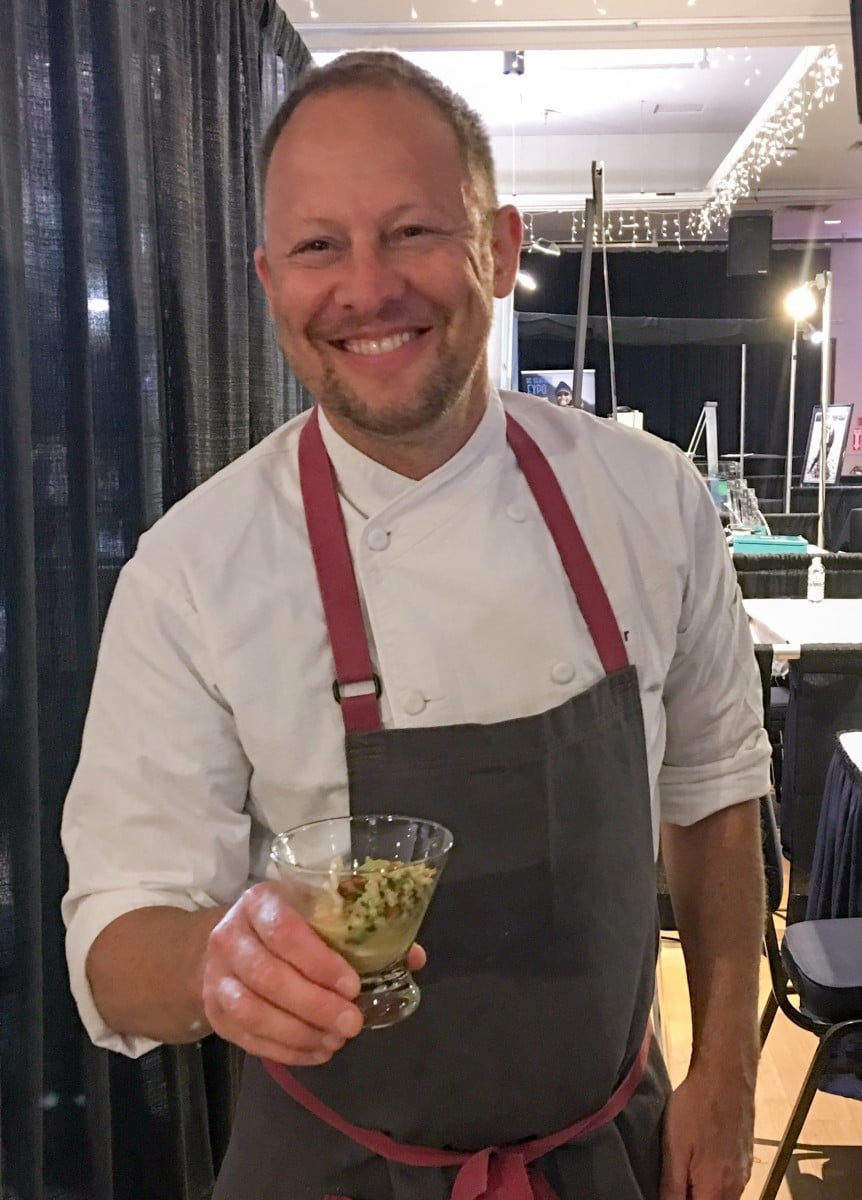
E. Michael Reidt with his geoduck ceviche. Photo by Tracy Ellen Beard.
British Columbia Salmon Farmers Association
During my stay, I was fortunate to visit the Hardwicke Island salmon farm. I bused out to the marina at Sayward, B.C., with a group from Comox Valley and then took a water taxi to the farm. The ride through the Seymour Narrows was stunning. Jeremy Dunn, the Executive Director of the BC Salmon Farmers Association joined us on the bus. He shared that the association is the fourth largest producer of farm-raised salmon in the world generating more than $1.1 billion towards the B.C. economy and providing jobs for more than 5,000 people. These farmers work diligently to keep up with the ever-increasing requests for salmon, and studies show that more than 50% of all seafood sold in the world comes from a farm.
Jeremy informed a colleague and me that B.C. farms use brood stock from wild Atlantic salmon. Jeremy told us that, “Pacific salmon are more wild and aggressive and don’t take to farming.” B.C. farmers mimic techniques used in Norway where years of experience have increased their success in salmon farming.
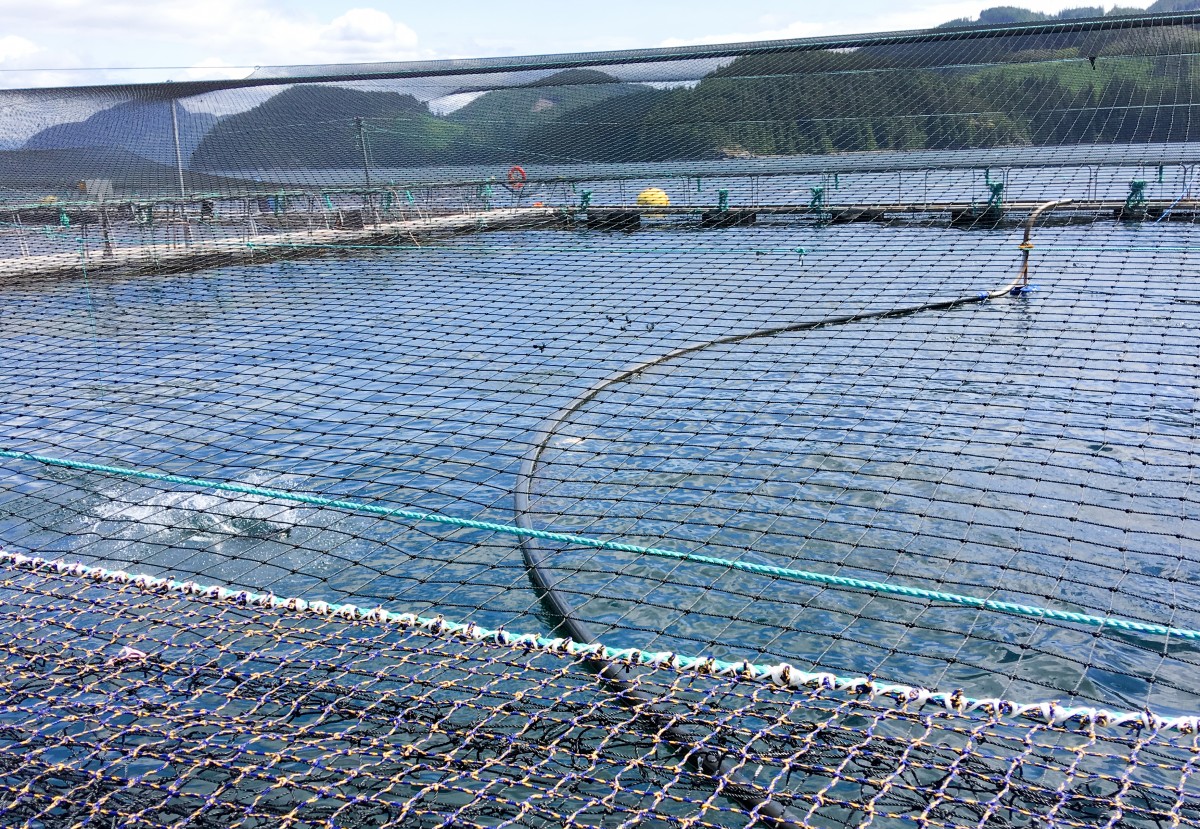
Sea Cage at Hardwicke Island. Photo by Tracy Ellen Beard.
The Salmon Life Cycle
Farming begins when salmon lay their eggs, and then those eggs are harvested. Over the next 18 months the small fish grow in a tank-based system, and once they reach the smolt phase in their life cycle, farmers move them from fresh water to salty water. At this point workers sedate and vaccinate the fish for endemic pathogens, and then they transfer them via a tanker truck to a well boat. The salmon live out their remaining years here until harvest. This entire process takes about three years.
The farm at Hardwicke Island is the size of two-football fields consisting of floating sea cages and a large warehouse with comfortable living quarters on the second floor. The netted cages are 90-feet deep with a ratio of 1 to 2 percent fish to 98 to 99 percent water. The nets, made of polyethylene, completely encircle each cage keeping out dangerous predators like seals, sea lion, and sea otters. These predators can consume hundreds of fish in a relatively short amount of time.
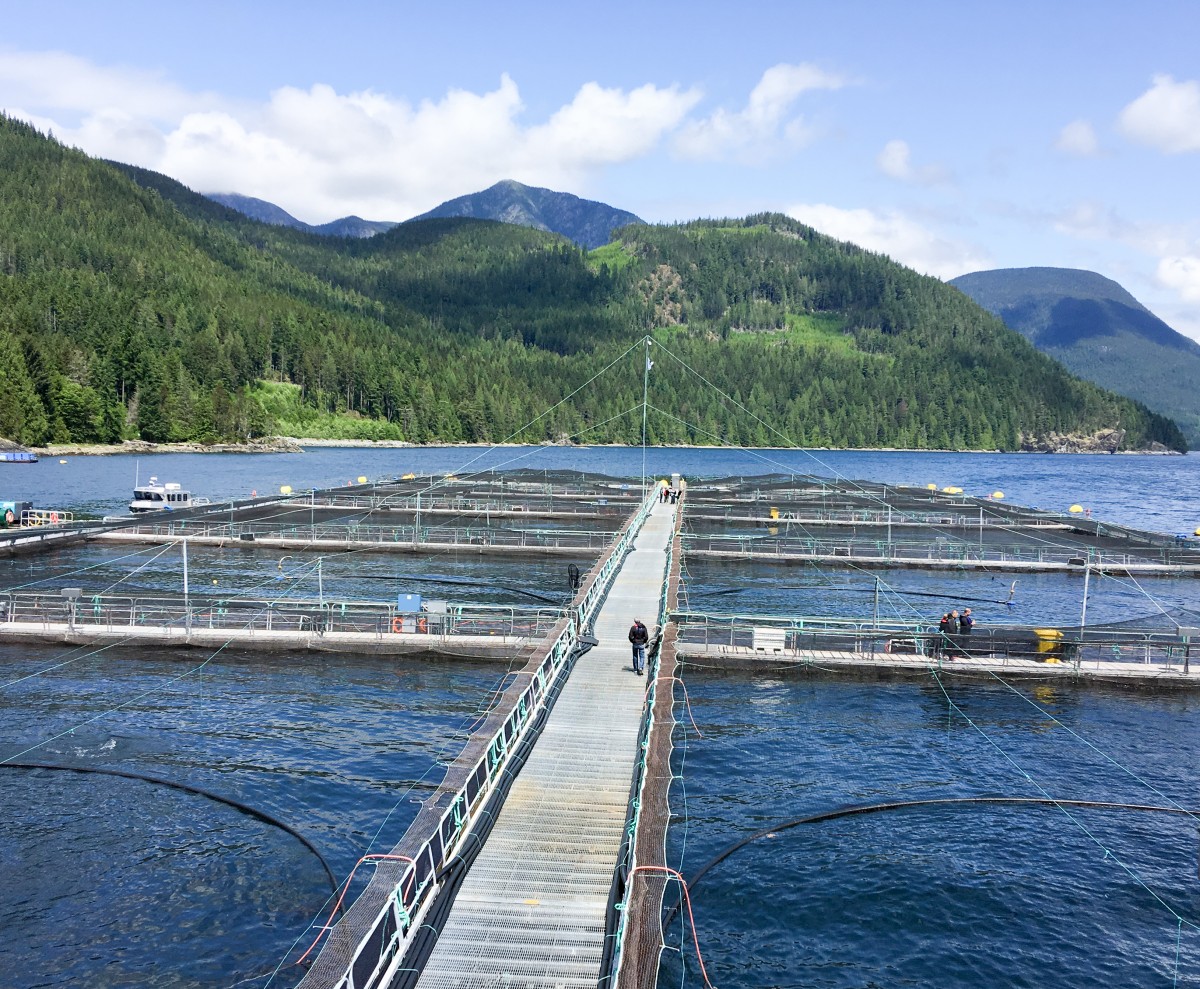
Hardwicke Island. Photo by Tracy Ellen Beard
Life at Hardwicke Island
Salmon at the farms eat a specially designed pellet developed from nutrient-rich food. The pellets, ejected out of a rotating pipe, spray into the air, and the salmon jump up to catch them like a dog would jump for a treat. Cameras monitor the pens from above and below the waterline giving employees an ability to monitor all salmon activity in the pens.
Employees at the farm work for one week and are off the next. Living on this little island has its pros and cons. The smell from the fish pellets is not particularly pleasant, and the hum from the feeders is a bit loud, but the views of the ocean and surrounding mountains are truly spectacular.
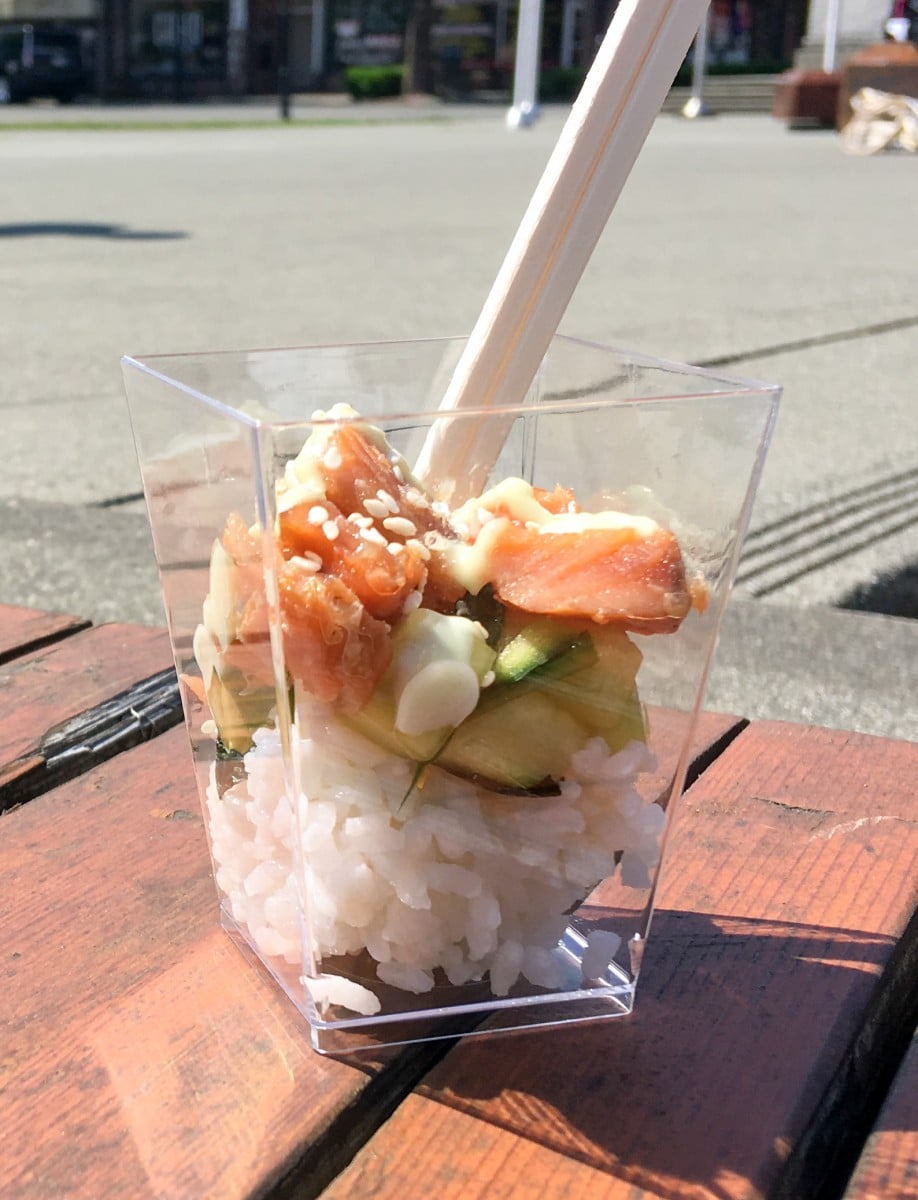
Salmon Appetizer at the Salmon Showdown. Photo by Tracy Ellen Beard.
Salmon and other seafood are a great source of Omega 3s, are low in calories, and are a healthy addition to the everyday diet. Thanks to aquaculture farmers in British Columbia, the world has an abundance of seafood options, so get out your cookbooks and serve some farm-raised seafood on your dinner plate tonight!
As is common in the travel industry, the writer was provided with meals and other compensation for the purpose of review. While it has not influenced this review, the writer believes in full disclosure of all potential conflicts of interest.

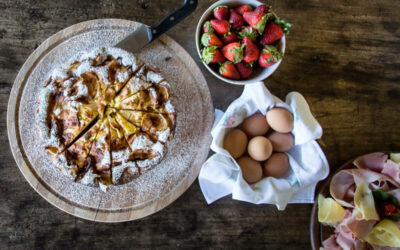


Can you show a picture or video underwater of salmon? Im native and for some reason im having a hard time seeing an actual salmon not diseased, deformed and full of little white parasites..
Yes indeed, let’s show people 10,000 salmon confined and swimming in a haze of poop and feed pellets. Not to mention sea lice and lots of open sores…
Tracey Beard, you obviously have never been underneath a bc salmon farm to see that everything is DEAD.
Also, you are not up to date on the diseases that these Atlantic’s have.
These penned fish also are eating wild stock herring and juvenile passing wild smolts are being plagued with sea lice.
Check out the facts pls, before you write about how great these farms are, you will be surprised indeed.
This is an important issue. As the publisher of Wander With Wonder, I am personally committed to protecting the environment and was an environmental writer long before I was a travel writer. I have no first hand knowledge of the salmon farms and cannot answer your questions in an informed manner at this moment. We are currently checking the facts about your concerns. We hear you. We hope to offer a complete follow-up in the near future.
While your effort to promote British Columbia is appreciated, you need to be better informed about the ongoing controversy surrounding the open net fin fish industry. This article presents itself like a paid ad by industry and ignores the environmental concerns, ongoing investigations by both federal and provincial governments into the integrity of the fish health testing system, an ongoing review of the practices at associated fish processing plants, opposition by First Nations… You would serve your audience better by looking to the emerging land-based system – check out Kuterra!
In reply to all the comments, I am aware that salmon farming is a controversial subject. However, salmon farms do exist. I visited the salmon farm in the article and I did look at the cameras underneath the water. The salmon looked fine to me and it appeared that they had enough room to swim, but I realize that this is a very debatable subject.
This story was not written to favor one side of the debate between having and not having farms, just my experience at the one I visited. These farms do exist and they are attempting to provide additional seafood sources for diners around the world.
I am also aware that there are very bad salmon farms, but the one I visited was managed quite well.
They may not have everything perfected, but there is a sustainability problem out there and the seafood farmers I visited are trying to help that. Over-fishing of wild salmon is another problem that can be added to the debate along with those that do not believe in eating any meat. Each person has their own opinions.
Again, my story was not meant to debate the issue of whether salmon farming is good or bad, but to state the fact that they do exist and that the one I visited is attempting to help feed the world.
I personally try not to get into big arguments about these debates because there are always two or more sides and some people are extremely passionate about their position on the issue. I wrote a story about my personal experience and my thoughts on the visit.
Rather than debating the issue between the good and bad of salmon farming, it would be awesome to rally ideas about ways to fix the ever-present problem of solving world hunger in a positive manner. People in this world consume huge amounts of seafood…lets work together to create some new and useful solutions.
Thank you for reading my story, your passion, and future ideas.
Are you people out of your minds? Wild Pacific salmon are the iconic species of British Columbia, not disgusting, disease-ridden Atlantic salmon raised in floating feedlots. How much did the Salmon Farmers Association pay you to print this crap?
This was NOT a paid placement. As the author commented, she made the trip and wrote about her observations. We welcome this open dialogue.
Dear Tracy and publisher,
Thank you for your article on Atlantic salmon aquaculture in British Columbia.
As you’re seeing from this and other comments, you’ve aroused a hornet’s nest. The open net-cage Atlantic salmon feedlot industry on the coast of BC is highly controversial: the industry is killing wild salmon, other wild fish and marine mammals (they are shot attempting to enter the net cages), and, in turn, the food and culture of indigenous nations.
One reason for the controversy is that so far no-one has seen a sea louse from a feedlot salmon jump onto, or a disease particle from a feedlot salmon pass through the gills of a migrating wild salmon smolt. The evidence is circumstantial, as independent biologist Alexandra Morton has been showing via peer-reviewed scientific papers over 30 years.
Here are links to films that will provide insight into the controversy:
https://www.youtube.com/watch?v=Jsr2Alfe708 (CTV W5 program, Oct 2017)
https://www.youtube.com/watch?v=fTCQ2IA_Zss (award-winning documentary 2013)
https://www.youtube.com/results?search_query=george+quocksister+jr (various videos 2017)
And here’s a few points to consider:
1. Over 90% of BC’s open net-cage salmon feedlots are owned by Norwegian and Japanese multinational corporations who care much about profit and nothing about our environment or indigenous culture.
2. Salmon are carnivores and must eat other wild fish, thereby depleting the marine food chain elsewhere and incurring environmental costs of transport, all leading to making the industry unsustainable.
3. Because of point 2. the industry is substituting vegetable and meat/fowl products in place of wild fish in feed.
4. Atlantic salmon are an alien species to the Pacific Ocean and don’t belong here. Thousands have escaped.
5. Sea floor areas under the feedlots are dead zones and feedlot waste has a detrimental effect on nearby shellfish beds, another indigenous food source.
6. Do you really want to eat a fish that has been vaccinated for endemic pathogens?
7. It is incredibly inhumane to trap a beautiful and powerful ocean-going creature such as this, that is meant to spend its entire life in wild freedom, in a cage.
8. The provincial and federal governments of Canada control BC’s feedlot industry; they deny the negative impacts of the feedlots and seem to be allowing continuation of a hidden agenda of genocide of the indigenous people.
9. The people of the Musgamagw Dzawada’enuxw nation of the Alert Bay area of coastal BC have never given their approval for the approximately 30 salmon feedlots placed in their traditional territory in the last 30 years. In fact, they have recently given eviction notices to the feedlot corporations, all of which have been ignored.
I hope this info helps bring you up to speed with the controversy; please also see Facebook pages Salmon Are Sacred and Swanson Occupation.
Perhaps you could consider publishing an article on the wild food of the Musgamagw Dzawada’enuxw nation in the near future.
On a personal note, please join us in our struggle to remove the Atlantic salmon feedlots from the coast of BC!
Very best wishes.
Laurie we at Wander SO appreciate you taking the time to share your knowledge and your expertise. This is exactly the type of dialogue we hope to encourage.
Hi Susan, thank you very much for posting my comments and for your kind reply. I’m impressed with Wander for venturing up the coast of Vancouver Island for this article!
I hope you will find the time to look at the videos. The major market for BC’s feedlot Atlantic salmon is the large USA food outlets such as Walmart, Costco and Sobeys/Safeway, obviously very unapproachable by those of us in Vancouver, Canada, so attempting to inform the market of the issues is frustrating for us.
To do that we need advocates against the feedlot industry with large contact networks such as yourself to help. I realize Wander is not a political vehicle, so feel free to contact me via email if you’d like to speak with Dr. Alexandra Morton or members of the Musgamagw Dzawada’enuxw nation on a personal basis, or perhaps you have a friend or colleague who may have an interest in our struggle.
As writer Tracy Beard is from Washington and Oregon, she may or may not be aware of last August’s escape of tens of thousands of Atlantic salmon from a Washington State feedlot owned by a Canadian corporation. Here’s yesterday’s US newspaper article explaining legislation contemplated by the Washington State Legislature to remove the feedlots – wish Canada had such courageous legislators!
http://www.chronline.com/atlantic-salmon-remain-in-legislative-crosshairs/article_eb9b5514-f2a6-11e7-b2ed-5b4e21566074.html
Thank you for an informative article. I am pleased you enjoyed your tour. It is unfortunate that some try to highjack your article for their own self interests. It never hurts to look into the facts, but be balanced in your study. Passion and facts are often and easily confused in this debate.
There are some great industries that are providing valued food in a very responsible way. Great to see these BC producers getting their recognition.
Best regards
What land’s on your plate with farmed Atlantic salmon is up to 10-times more PCBs and other pesticides than a plate full of farmed land animal meat. Due to salmon’s uptake from feed we already know that the feeds can “…provide commercially relevant feed-to-fillet transfer factors (calculated as fillet POP level divided by feed POP level), which ranged from 0.4 to 0.5, which is a factor 5-10 times higher than reported for terrestrial meat products.”
Chemosphere. 2011 Mar;83(2):95-103. doi: 10.1016/j.chemosphere.2011.01.017. Epub 2011 Feb 1.
Carry-over of dietary organochlorine pesticides, PCDD/Fs, PCBs, and brominated flame retardants to Atlantic salmon (Salmo salar L.) fillets.
Link: https://www.ncbi.nlm.nih.gov/pubmed/21284993
Hi Tracey,
I think your article was great until I scrolled down to the BC Salmon Farmers Association part. It really is a tough subject for a lot of people. Losing the wild salmon will be detrimental to the work that organizations like Destination British Columbia is doing. Our iconic species will fall, and this is one of the main reasons for international travellers to come to Super Natural British Columbia.
What I would love to offer you is a free trip with Sea Wolf Adventures to hear and see the other side of the story. I will take you into the heart of Great Bear Rainforest South to view our Grizzly Bears and other wildlife and we’ll ride past 20 plus salmon farms.
Tracey, contrary to what some are saying here. You did a great job promoting sustainable seafood in BC.
Nearly all of the negative assertions here are contradictory to a wide body of research conducted by leading scientists in Canada and in other parts of the world.
I refer to a paper titled “Lethal Atlantic virus found in Pacific salmon”. That paper was proven to be false leading to the laboratory that did the screening work to lose its international accreditation. The lab is the same one that did the work on the current study.
The Minister of Fisheries and Oceans then stated, “because some have chosen to draw conclusions based on unconfirmed information, this has resulted in British Columbia’s fishing industry and Canada’s reputation being put at risk needlessly.”
The activist-scientists were also warned by the BC Government and Fisheries and Oceans Canada that reckless allegations based on incomplete science can be devastating and unfair to the families that make a living from the sea.
Gary Marty, a veteran scientist with the BC Ministry of Agriculture, Animal Health Centre said BC farmed
More than eight million Atlantic salmon have been intentionally released into B.C. rivers and lakes, beginning more than a century ago.But history has shown that Atlantic salmon don’t feed well in the Pacific and have never established spawning populations outside their natural range despite transplant programs around the world.
http://vancouversun.com/news/local-news/millions-of-atlantic-salmon-introduced-to-b-c-streams-since-1905
Also refer you to this story –
After more than a decade of U.S.-funded attacks targeted exclusively on B.C.’s salmon farm industry, the tide is finally turning. The fake-news tactics of hired protesters have become so obvious that even some news media aren’t biting any more. http://www.columbiavalleypioneer.com/opinion/salmon-farm-smear-campaign-sinks/
And here is another one – http://www.cbc.ca/news/canada/british-columbia/risk-of-viral-transfer-from-b-c-fish-farms-to-wild-sockeye-is-low-study-1.4459044 – which states Risk of viral transfer from B.C. fish farms to wild sockeye is low: study.
Thank you